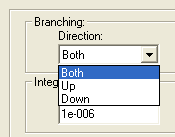Direction |
LINGO uses a branch-and-bound solution procedure when solving integer programming models. One of the fundamental operations involved in the branch-and-bound algorithm is branching on variables. Branching involves forcing an integer variable that is currently fractional to either the next greatest or the next lowest integer value. As an example, suppose there is a general integer variable that currently has a value of 5.6. If LINGO were to branch on this variable, it would have to choose whether to set the variable first to 6 or 5. The Direction option controls how LINGO makes this branching decision.
If you pull down the drop-down box for the Direction option, you’ll find the following:

The default setting, Both, involves LINGO making an intelligent guess as to whether it should branch up or down first on each individual variable. If Up is selected, LINGO will always branch up first. If Down is selected, LINGO will always branch down first. In most cases, the Both option will result in the best performance.
